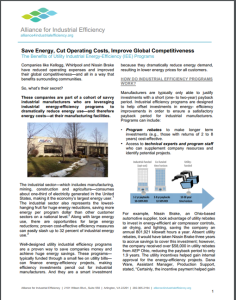The Alliance for Industrial Efficiency recently published a new factsheet that details how manufacturers benefit when they “opt in” to utility industrial energy-efficiency programs.
Although energy use presents a significant cost to manufacturers, there are often cost-effective energy- saving opportunities that companies have not yet captured. Large industrial customers typically report that their energy-efficiency investments must realize a very short (one- to two-year) payback period requirement, which means that many projects that are cost-effective in the long-term will not be approved and initiated.
Utilities have a much larger appetite for long-term investments than manufacturers, allowing them to subsidize projects that may not bring quick returns. Through incentives and rebates, utility programs offset up-front investment in energy efficiency. An industrial customer who would not invest in an energy-efficiency project with a four-year payback period, would be able to offset some of the costs with utility incentives, reducing the payback to two years or less, and meeting their short payback requirement.
For example, Nissin Brake, an Ohio-based automotive supplier, received rebates from AEP Ohio for investing in energy-efficient air compressor controls, air drying, and lighting, saving the company over 800,000 kilowatt-hours per year. The utility rebates reduced the payback period from three years to less than two, making the investment viable. In fact, Nissin Brake has stated that they would not have invested in the energy-efficiency improvements if the AEP Ohio program did not exist. Another example highlighted in the fact sheet is Kellogg USA’s Battle Creek, Michigan plant, which saves nearly $90,000 annually in energy costs due to efficiency improvements made through a utility incentive program.
As states look ahead to ways to reduce greenhouse gas emissions and cut energy use, the Alliance’s new fact sheet is a valuable reminder of the huge gains that can be achieved with industrial efficiency measures. While large manufacturers are clear beneficiaries of industrial efficiency programs, utility customers from all sectors benefit from lower electricity demand. Reducing demand for energy allows utilities to defer power plant construction or transmission and distribution system upgrades, resulting in lower bills for everyone. Long-term energy cost savings for all customers is something everyone can appreciate!

